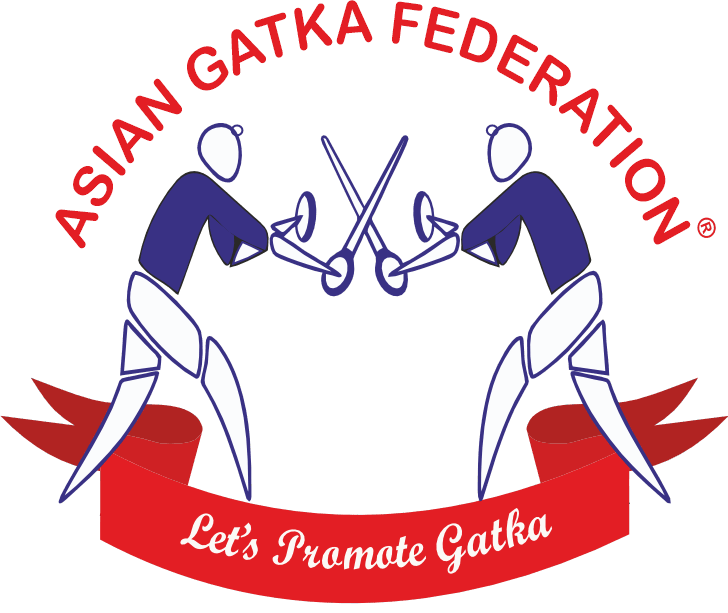Brief History: Gatka Becomes Game
From Ancient Shastar Vidya to a Recognised Global Martial Sport
Sikh martial art {Shastar Vidya (ਸ਼ਸਤਰ ਵਿਦਿਆ)} and Gatka, a complete traditional self-defence system, were developed and institutionalised by the Sikh Gurus about five centuries ago. This warrior tradition emerged during an era of foreign invasions and political-religious persecution of Sikhs, preparing the Sikh community not only for self-defence but also for righteous warfare.
This vast and dynamic Shastar Vidya/Kala encompassed the mastery of a wide range of traditional weapons, combat techniques and battlefield strategies. However, during the Mughal period and later under British colonial rule, Sikhs were subjected to repeated bans on carrying or practicing with sharp-edged weapons. In response, Sikh warriors, many of whom took refuge in forests, preserved their martial heritage through the practice of Gatka Soti, a safe and wooden substitute for the sword.
As a result, Gatka Soti (stick combat) emerged as both a fundamental training technique and a performance format, simulating swordplay while keeping alive the spirit and structure of traditional combat.
First Documented Manual on Gatka – 1936 :
The first formal publication documenting basic Gatka techniques was authored by Kartar Singh Akali, then Physical Director of RSD College, Ferozepur. His book, published in 1936 by the University of Lahore, in Pakistan, became the foundational instructional manual for learning and teaching Gatka in educational institutions. This landmark publication marked a pivotal moment in the journey of Gatka, transforming it from an oral tradition and battlefield practice into a codified and teachable martial art.
Revival and Sportification in the Modern Era :
With a vision to promote and preserve Gatka as a mainstream martial sport, the National Gatka Association of India (NGAI) was established in 2002 and formally registered in 2004, becoming the first and oldest national Gatka organisation in India. The NGAI initiated structured efforts to standardise Gatka, creating defined rules, age categories and competition formats.
In 2011, the first Gatka Rules Book was drafted under the banner of the World Gatka Federation (WGF) in an effort to establish international norms and regulations. The WGF was officially registered in 2018, followed by the establishment of the Asian Gatka Federation (AGF) in the same year. Subsequently, the Commonwealth Gatka Federation and European Gatka Federation were also formed to support continental development. Moreover, national Gatka Federations are being formed in many countries.
Global Standardisation and International Rule Book :
To modernise the sport and ensure its global acceptance, World Gatka Federation has continuously updated its official International Gatka Rules and Regulations Book. As of October 2025, WGF has released the 4th Edition, featuring:
- Systematically developed techniques for learning, coaching, officiating and refereeing
- Updated and standardised rules for Gatka Soti, Farrie Soti, and Mixed Events
- Codified equipment specifications, age-group structures, scoring systems, penalty codes and TSR (Time, Scoring & Result) technologies
- Comprehensive guidelines to address anti-doping, age fraud, Stuntbazi and enforcement of black card penalties
This exhaustive official statute reflects WGF’s mission to institutionalise Gatka as a globally recognised, professionally administered martial sport, while preserving its spiritual and historical essence.
Recognition and Achievements :
Through more than two decades of committed efforts by NGAI under the leadership of WGF and AGF :
- Gatka game has been included in the four mainstream games of India
- Included in the National Pythian Cultural Games and International Pythian Games
- Numerous state, national and international championships are being successfully organised
- Technological advancements such as synthetic interlocking mats, digital registration, TSR systems and video replay have enhanced game fairness and infrastructure
- Training modules, equipment standards and officiating protocols have been standardised nationwide
These achievements stand as a testament to the visionary leadership of NGAI, the strategic guidance of WGF and the dedicated community of certified players, referees and coaches who continue to elevate Gatka globally.
WGF and AGF, in collaboration with NGAI, remain committed to:
- Promoting Gatka as a globally recognised sport with rich spiritual and cultural foundations
- Working toward its inclusion in major multisport international platforms such as the Asian Games, Commonwealth Games and ultimately the Olympic Games
- Building a new generation of certified athletes, coaches, referees and technical officials
- Preserving the invaluable heritage of Sikh Shastar Vidya through systematic training and international exposure
Gatka, once practiced in the jungles by persecuted Sikh warriors, now stands on the global stage, as a symbol of resilience, discipline, dignity and spiritual power, bridging the past with the future.
